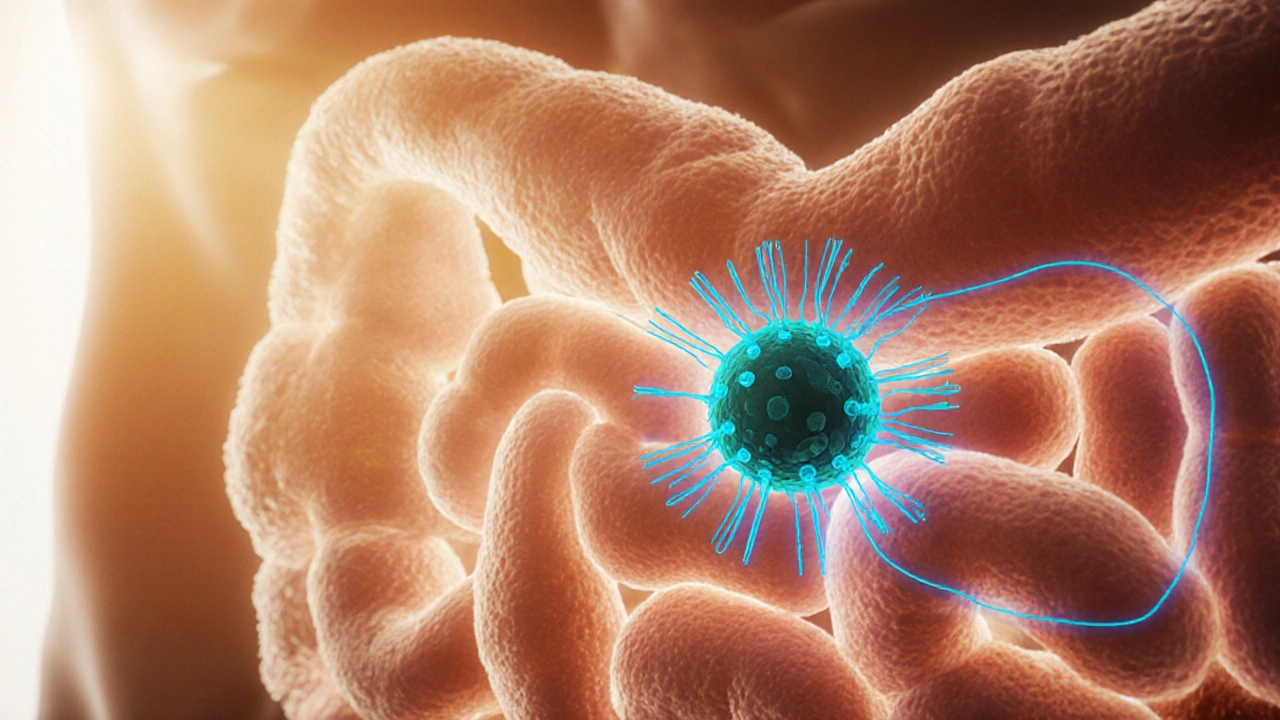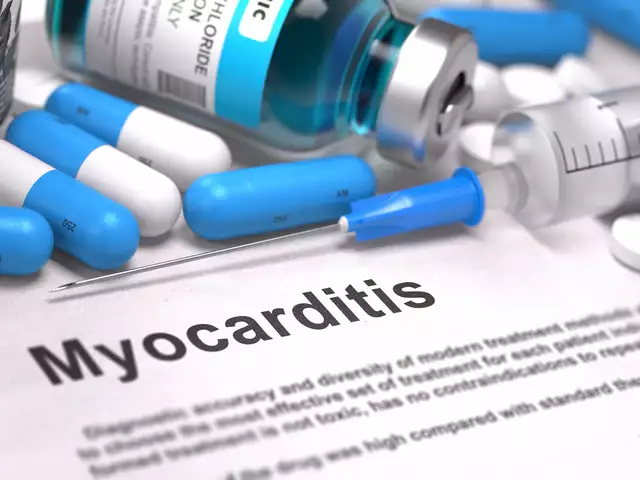When it comes to managing high LDL cholesterol, the market is packed with options, but not all drugs work the same way or fit every patient’s lifestyle. This guide breaks down Ezetimibe and puts it side‑by‑side with the most common alternatives so you can see where it shines, where it falls short, and how to pick the right fit for your heart‑health goals.
What is Ezetimibe?
Ezetimibe is a cholesterol‑absorption inhibitor that blocks the Niemann‑Pick C1‑like 1 (NPC1L1) protein in the small intestine, reducing the amount of dietary and biliary cholesterol that enters the bloodstream. It was first approved by the FDA in 2002 and is sold under brand names like Zetia.
The usual dose for adults is 10mg once daily, taken with or without food. Because it works in the gut rather than the liver, ezetimibe can be combined with a statin for an additive effect, or used alone when statins are not tolerated.
Key Alternatives to Ezetimibe
Before diving into numbers, let’s list the main drug families you’ll encounter when your doctor talks about “cholesterol‑lowering alternatives.”
- Statins - e.g., atorvastatin, rosuvastatin. They inhibit HMG‑CoA reductase, cutting cholesterol synthesis in the liver.
- PCSK9 inhibitors - monoclonal antibodies such as evolocumab and alirocumab that boost LDL‑receptor recycling.
- Bile‑acid sequestrants - like cholestyramine, which bind bile acids in the gut and force the liver to use more cholesterol to make new bile.
- Niacin (nicotinic acid) - a vitamin B3 derivative that lowers LDL and raises HDL, though its use has waned due to side effects.
- Lifestyle modification - diet, exercise, and weight control, which can cut LDL by 5‑15% on their own.
How Much Does Each Option Lower LDL?
Clinical trials give us a ballpark of how much each class can reduce low‑density lipoprotein (LDL) cholesterol, the primary culprit in atherosclerotic cardiovascular disease.
| Drug / Approach | Mechanism | Typical LDL Reduction | Common Side Effects | Typical Cost (AU$/month) | Regulatory Status |
|---|---|---|---|---|---|
| Ezetimibe | NPC1L1 inhibition (intestinal absorption) | 15‑20% | GI upset, rare liver enzyme rise | ≈30‑45 | Prescription (FDA, TGA approved) |
| Statins (e.g., atorvastatin) | HMG‑CoA reductase inhibition (hepatic synthesis) | 30‑55% | Muscle aches, elevated CK, diabetes risk | ≈10‑25 | Prescription (widely approved) |
| PCSK9 inhibitors (evolocumab) | Monoclonal antibody (LDL‑receptor recycling) | 50‑65% | Injection site reactions, flu‑like symptoms | ≈600‑800 | Prescription (specialist‑only) |
| Bile‑acid sequestrants (cholestyramine) | Bind bile acids in gut | 10‑15% | Constipation, GI bloating | ≈20‑35 | Prescription/OTC in some countries |
| Niacin | Inhibits hepatic VLDL production | 15‑25% (LDL) | Flushing, hyperglycemia, gout | ≈15‑30 | Prescription (limited use) |
| Lifestyle changes | Dietary fiber, plant sterols, exercise | 5‑15% | None (adherence challenge) | Free‑to‑low | Non‑pharmacologic |
Notice how ezetimibe’s 15‑20% drop sits between bile‑acid sequestrants and high‑intensity statins. When paired with a low‑to‑moderate dose statin, the combined reduction can reach 35‑45%-a strategy often used for patients who can’t tolerate high‑dose statins.
Safety Profile: What to Watch For
Every cholesterol drug has a unique side‑effect signature. Here’s a quick look at the safety landscape.
- Ezetimibe: Generally well‑tolerated. Mild abdominal discomfort is the most common complaint. Liver‑enzyme elevations are rare and usually reversible after discontinuation.
- Statins: Muscle pain (myalgia) is the headline concern, occurring in up to 10% of users. A small subset develops rhabdomyolysis, a serious condition requiring immediate medical attention. Statins also raise the risk of new‑onset diabetes, especially at higher doses.
- PCSK9 inhibitors: Because they’re injected, patients may experience bruising or soreness at the site. Systemic side effects are low, but the high cost limits routine use.
- Bile‑acid sequestrants: They can cause constipation and interfere with absorption of fat‑soluble vitamins (A, D, E, K). Timing of other medications matters; they can reduce the effectiveness of some drugs if taken together.
- Niacin: The dreaded flushing-red, warm skin-affects most users unless pre‑treated with aspirin. Long‑term use can worsen blood sugar control and raise uric acid levels, provoking gout attacks.
- Lifestyle changes: No pharmacologic risks, but adherence is the biggest hurdle. Dietary changes need sustainable planning, and exercise must be matched to physical ability.
Cost Considerations in Australia (2025)
Affordability often decides which therapy becomes the default. Below is a snapshot of typical out‑of‑pocket costs after the government’s Pharmaceutical Benefits Scheme (PBS) subsidies, where applicable.
- Ezetimibe: Around AU$30‑45 per month after PBS; a generic version entered the market in 2024, shaving off about 20%.
- Statins: Most are PBS‑listed; patients pay about AU$4‑10 per month for a 30‑day supply.
- PCSK9 inhibitors: Not PBS‑covered for primary prevention; specialist‑prescribed patients may pay upwards of AU$800 per month.
- Bile‑acid sequestrants: Often cheaper, about AU$20‑35 monthly, but require multiple daily doses which can affect adherence.
- Niacin: Generic niacin is inexpensive (AU$5‑12/month), yet many doctors avoid it due to side‑effect profile.
- Lifestyle changes: Free, but programs (dietitian, gym memberships) can add AU$50‑150 per month.
For many Australians, a statin plus ezetimibe combo fits well within the PBS safety net while delivering robust LDL reduction.

Choosing the Right Therapy: A Simple Decision Framework
Not everyone needs the most potent drug. Use the following checklist to discuss options with your healthcare provider.
- Baseline LDL and cardiovascular risk: If LDL is >190mg/dL or you have established atherosclerotic disease, high‑intensity statin therapy is first‑line.
- Statin tolerance: Muscle pain or liver concerns may push you toward ezetimibe or a bile‑acid sequestrant.
- Cost & insurance coverage: PBS‑listed statins are cheap; if you need additional lowering, ezetimibe is the next most affordable PBS‑supported option.
- Need for rapid, deep LDL cut: For familial hypercholesterolemia or patients failing to meet targets on oral meds, PCSK9 inhibitors become justified.
- Comorbidities: Diabetes, liver disease, or renal impairment may influence drug choice; for instance, niacin is avoided in diabetics.
- Patient preferences: Oral daily pills vs. monthly injection, potential side effects, and lifestyle willingness all matter.
When two or more criteria point to ezetimibe-moderate LDL levels, statin intolerance, and reasonable cost-it becomes a solid middle‑ground choice.
Practical Tips for Using Ezetimibe Effectively
- Take the tablet at the same time each day; food does not affect absorption.
- If you’re on a statin, schedule blood tests 4‑6 weeks after starting the combo to check liver enzymes and confirm LDL drop.
- Stay hydrated and maintain a balanced diet; although ezetimibe blocks cholesterol entry, dietary fat still provides calories.
- Report any persistent abdominal pain or unexplained fatigue to your doctor-these could signal a rare side effect.
Frequently Asked Questions
Can I take ezetimibe without a statin?
Yes. Ezetimibe works alone by limiting intestinal cholesterol absorption. It’s prescribed for patients who can’t tolerate any statin or who have only modest LDL elevations.
How quickly does ezetimibe lower LDL?
LDL begins to fall within 2‑4 weeks of starting therapy, with the maximum effect reached by week 8. Routine labs are usually drawn at 6‑8 weeks to gauge response.
Is ezetimibe safe for people with liver disease?
Because ezetimibe does not rely on hepatic metabolism, it is generally safe for mild‑to‑moderate liver impairment. However, liver‑function tests are still recommended at baseline and during follow‑up.
Do I need to continue lifestyle changes while on ezetimibe?
Absolutely. Medications lower LDL, but diet, exercise, and weight control provide additional cardiovascular benefits and help keep the drug’s effect stable over the long term.
What are the main reasons doctors choose PCSK9 inhibitors over ezetimibe?
PCSK9 inhibitors can slash LDL by over 60% and are effective in patients with familial hypercholesterolemia or those who don’t reach targets even on statin + ezetimibe. The trade‑off is higher cost and the need for sub‑cutaneous injection every 2‑4 weeks.





October 12, 2025 AT 00:35 AM
Ezetimibe is just another pharma cash grab.
October 14, 2025 AT 08:08 AM
While the article lists the AU$30‑45 price tag, it conveniently glosses over the fact that many patients never see the PBS subsidy until they hit a certain threshold. In other words, the “affordable” label is a bit of a smokescreen. Moreover, the author fails to mention that the generic version’s bioavailability can vary batch‑to‑batch, which is a non‑trivial detail for clinicians.
October 16, 2025 AT 15:42 PM
Look, the United States has been over‑prescribing statins for decades, so it’s no surprise that ezetimibe is marketed as a “middle‑ground” option 😊. The drug’s modest 15‑20 % LDL drop is hardly revolutionary, yet the pharma lobby pushes it like it’s the next big thing. If you ask me, the real win would be a diet that actually works, not another pill with a fancy mechanism.
October 18, 2025 AT 09:22 AM
From a philosophical standpoint, the choice of therapy reflects a balance between autonomy and beneficence-patients should be empowered to weigh cost, efficacy, and lifestyle without being coerced by industry narratives.
October 20, 2025 AT 03:02 AM
Imagine your arteries as a bustling marketplace; ezetimibe is the diligent gatekeeper who politely refuses a few extra cholesterol tourists, while statins are the stern bouncers shoving everyone out. Both have their charm, but the gatekeeper’s subtle touch can be a poetic compromise for those who dislike the bouncer’s rough tactics.
October 22, 2025 AT 10:35 AM
Ezetimibe, introduced in 2002, represents a distinct pharmacological class that inhibits intestinal cholesterol absorption via blockade of the NPC1L1 transporter. This mechanism contrasts sharply with the hepatic HMG‑CoA reductase inhibition characteristic of statins, thereby offering a complementary pathway for LDL reduction. Clinical trials have consistently demonstrated a mean LDL decrease of approximately 15 % to 20 % when ezetimibe is administered as monotherapy. When combined with a low‑to‑moderate dose statin, additive effects yield reductions in the range of 35 % to 45 %, a synergy that has been validated in multiple randomized controlled studies. The safety profile of ezetimibe is generally favorable; adverse events are limited mostly to mild gastrointestinal discomfort and rare elevations in hepatic transaminases. Unlike statins, ezetimibe does not carry a significant risk of myopathy or new‑onset diabetes, making it an attractive option for patients intolerant to statins. Cost considerations in the Australian context further differentiate ezetimibe, with PBS‑subsidized pricing placing it well below the steep monthly fees associated with PCSK9 inhibitors. Nevertheless, the drug’s modest efficacy must be weighed against lifestyle interventions, which can achieve LDL reductions of up to 15 % without pharmacologic side effects. In patients with baseline LDL levels exceeding 190 mg/dL or established atherosclerotic disease, guideline‑directed high‑intensity statin therapy remains first‑line. For individuals who cannot tolerate high‑dose statins, ezetimibe offers a viable therapeutic bridge before escalating to more costly biologics. It is also worth noting that ezetimibe’s pharmacokinetics are not heavily reliant on hepatic metabolism, rendering it suitable for patients with mild to moderate liver impairment. However, routine monitoring of liver function tests is still advisable at therapy initiation and during follow‑up. The drug’s once‑daily oral dosing schedule enhances adherence compared with the injectable regimen required for PCSK9 inhibitors, which often demand biweekly or monthly administrations. Patient preference, therefore, plays a pivotal role in shared decision‑making processes. Ultimately, the clinician must integrate individual risk profiles, comorbid conditions, cost constraints, and patient values to determine whether ezetimibe occupies a central or peripheral position in the cholesterol‑lowering armamentarium. Ongoing research may further elucidate its role in combination therapies, particularly in the context of emerging lipid‑modifying agents. In summary, ezetimibe provides a modest yet clinically meaningful LDL‑lowering effect, a favorable safety margin, and a cost advantage that together justify its inclusion in personalized treatment algorithms.
October 23, 2025 AT 00:28 AM
Great overview, Larry! Your breakdown really clarifies where ezetimibe fits into the bigger picture and helps patients see the trade‑offs clearly.
October 23, 2025 AT 08:48 AM
I think we’re over‑complicating it-most people just need a cheap, tolerable option, and ezetimibe checks those boxes.
October 25, 2025 AT 16:22 PM
For anyone struggling with statin side effects, remember that adding ezetimibe can often bring your LDL down to target without ramping up the dose, which can be a lifesaver.
October 27, 2025 AT 09:02 AM
Did you know the pharma lobby secretly funded the “cost‑effectiveness” studies on ezetimibe? 🤔 They want us to think it’s affordable while the real profit comes from the pricey brand versions.
October 29, 2025 AT 16:35 PM
Oh sure, because nothing says “heart‑healthy” like trusting a pill that was invented to keep the cholesterol‑boosting snack industry afloat-sarcasm aside, the data do show modest benefits when used appropriately.
October 31, 2025 AT 10:15 AM
Gotta say, the article could've used a bit more Aussie slang-like “no worries, mate” when talking about the cheap PBS price. Also, watch out for the occasional “its” vs “it's”.
November 2, 2025 AT 17:48 PM
I'm curious how ezetimibe performs in real‑world diverse populations, especially those with limited access to regular blood tests-any data on adherence outside clinical trials?
November 4, 2025 AT 11:28 AM
From a motivational standpoint, combining ezetimibe with a solid exercise regimen can amplify results far beyond what the drug alone can achieve-push past the plateaus!
November 6, 2025 AT 19:02 PM
Everyone praises ezetimibe but forgets the hidden metabolic shifts that could trigger long‑term issues ignore the hype